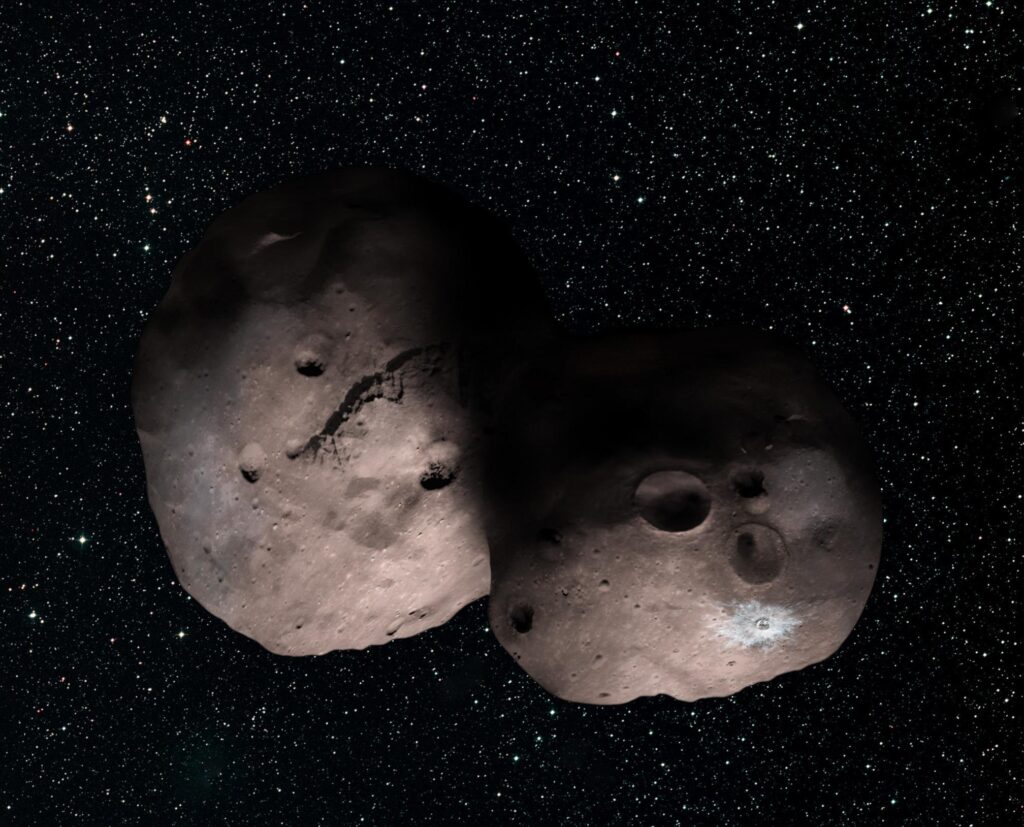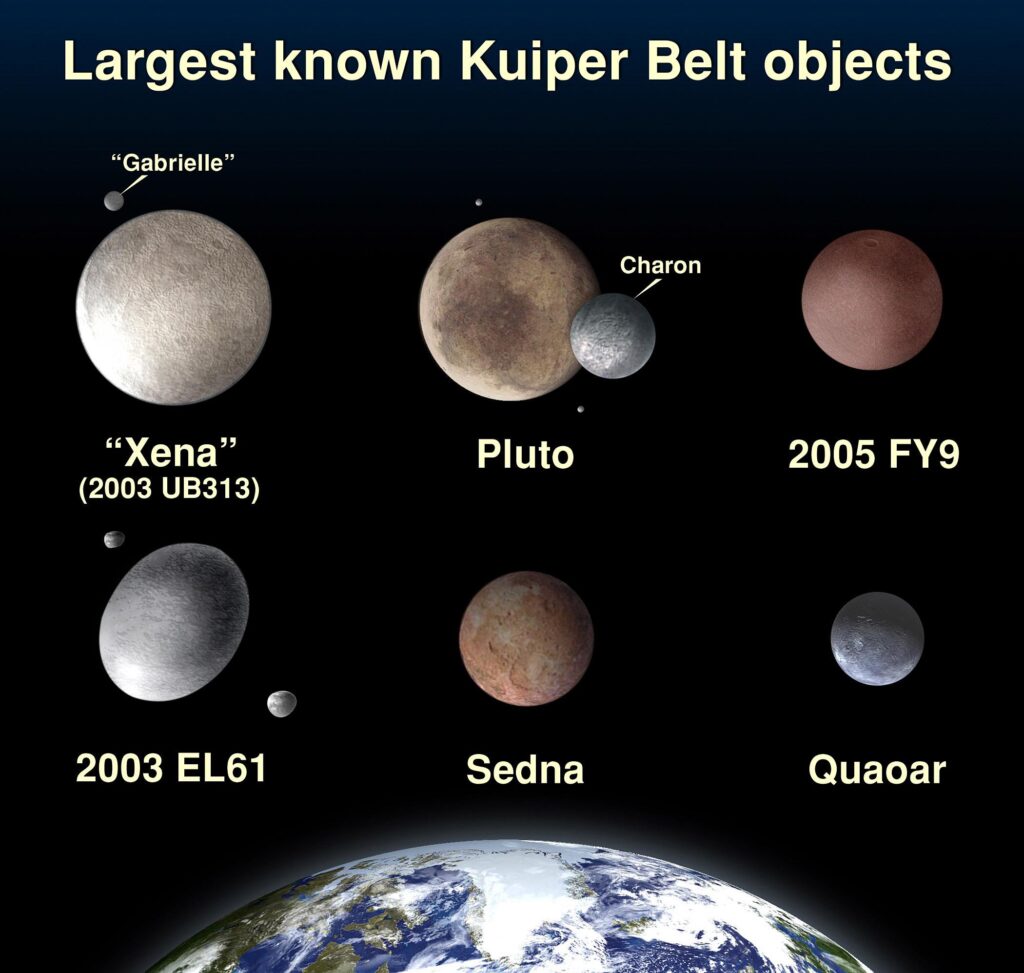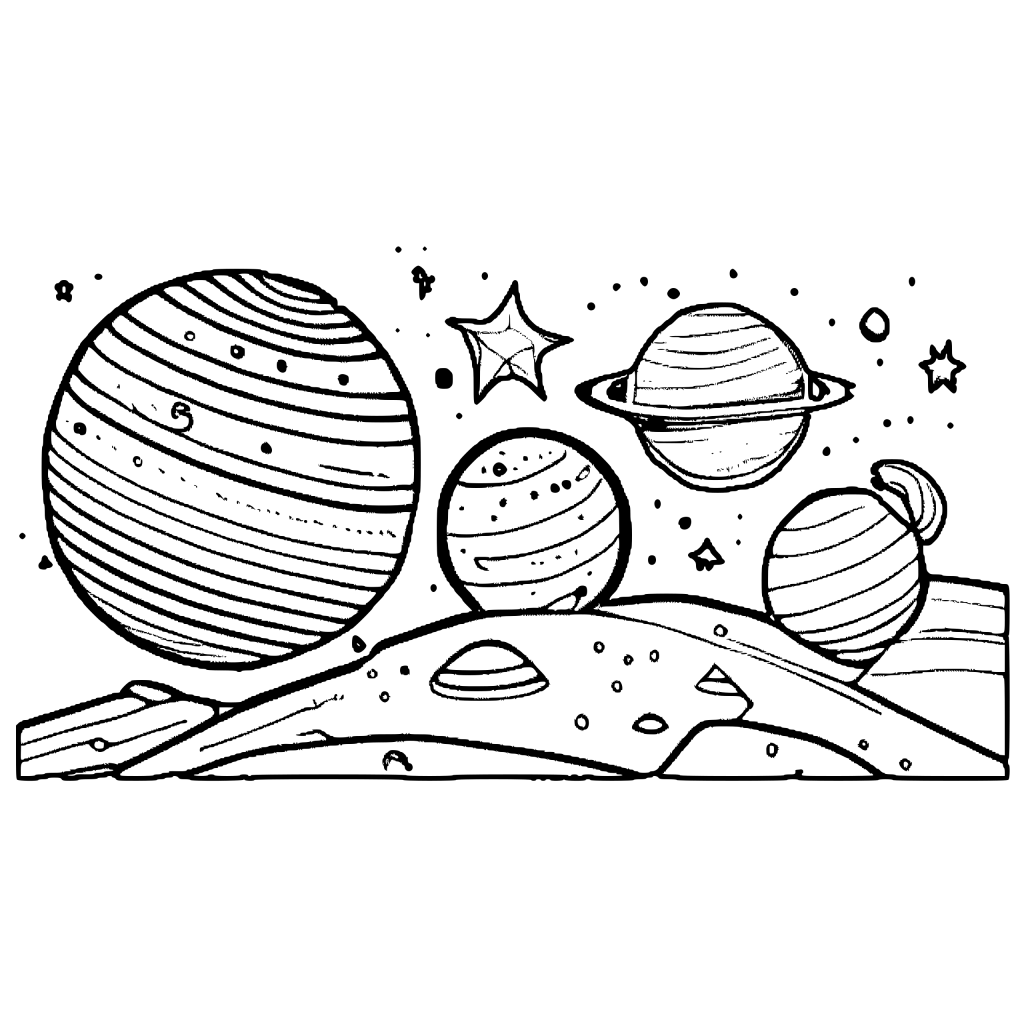Exploring the Outer Fringes of our Solar System
© ESO/M. Kornmesser
The Kuiper belt, also known as the Edgeworth-Kuiper belt, is a broad, flat ring of icy small celestial objects orbiting the Sun. It extends from roughly 30 astronomical units (AU) to about 50 AU beyond the orbit of Neptune. While sharing some similarities with the asteroid belt, it is significantly larger, being about 20 times wider and 20–200 times more massive. Like the asteroid belt, it primarily comprises small bodies or remnants from the early formation of the Solar System. While a significant number of asteroids are primarily made up of rock and metal, the majority of Kuiper belt objects consist mainly of frozen volatiles, referred to as “ices,” which include substances like methane, ammonia, and water.
Within the Kuiper belt, astronomers recognize several objects as dwarf planets, including Orcus, Pluto, Haumea, Quaoar, and Makemake. Additionally, it’s possible that certain moons in the Solar System, like Neptune’s Triton and Saturn’s Phoebe, may have originated from this area. Kuiper Belt Objects are sometimes categorized into two main groups: Trans-Neptunian Objects (TNOs), which orbit beyond Neptune but remain relatively close to the plane of the solar system, and Centaurs (CNOs), which have orbits that are more unstable and can cross the orbits of the gas giants.
Similar to the main asteroid belt, the Kuiper Belt’s formation was influenced by the orbit of a massive planet. While the gas giant Jupiter fabricated the structure of the main asteroid belt, it was the orbit of Neptune that prevented the material from coalescing into a large planet and thus carved out the thin disk of the Kuiper Belt.
FORMATION AND EVOLUTION

The formation and evolution of the Kuiper Belt, a region of the solar system located beyond the orbit of Neptune, is a complex and fascinating subject. While our understanding of this region is still evolving, scientists have developed several theories and models to explain its origins and how it has evolved.
FORMATION
SOLAR NEBULA THEORY
Like the rest of the solar system, the Kuiper Belt is thought to have originated from the solar nebula, a cloud of gas and dust left over from the formation of the Sun. Within the solar nebula, solid particles began to accrete, forming planetesimals.
ACCRETION OF PLANETESIMALS
Over millions of years, these planetesimals collided and merged, gradually forming larger and larger objects. Some of these objects eventually grew into protoplanets, which are early-stage planetary bodies.
NEPTUNE’S INFLUENCE
The presence of Neptune played a crucial role in the Kuiper Belt’s formation. Neptune’s gravitational influence limited the growth of objects in the Kuiper Belt by scattering or ejecting many planetesimals and preventing them from coalescing into larger planets.
CAPTURE OF ICY BODIES
Some objects in the Kuiper Belt are believed to be captured icy bodies from the outer regions of the solar system. These objects may have been gravitationally influenced by Neptune and other giant planets, causing them to be pulled into the Kuiper Belt.
EVOLUTION
RESONANCE AND ORBITAL DYNAMICS
The Kuiper Belt is a region characterized by complex orbital dynamics and resonances with Neptune. Some Kuiper Belt objects are locked in resonant orbits with Neptune, meaning they complete specific fractions of their orbits for every one of Neptune’s orbits. These resonances can lead to stable or unstable orbits, influencing the long-term evolution of objects in the Kuiper Belt.
COLLISION AND FRAGMENTATION
Collisions among Kuiper Belt objects have played a significant role in their evolution. High-velocity impacts can lead to fragmentation, creating smaller objects and generating dust. Over time, these collisions can reshape the Kuiper Belt’s population and create debris.
GRAVITATIONAL INTERACTIONS
Gravitational interactions with Neptune and other outer planets can lead to the scattering of Kuiper Belt objects into different orbits. Some objects may be ejected from the Kuiper Belt altogether and become part of the scattered disk or the Oort Cloud.
Read article “KUIPER BELT VS. OORT CLOUD” to understand the difference.
INFLUENCE OF PLANET NINE HYPOTHESIS
Some models suggest that the hypothetical ninth planet if it exists in the outer solar system, could influence the dynamics of the Kuiper Belt and explain certain observed patterns of orbital behaviour.
LONG-TERM STABILITY
Despite the dynamic nature of the Kuiper Belt, some objects have remained in relatively stable orbits for billions of years. Understanding the mechanisms that allow for this stability is an ongoing area of research.
INFLUENCE ON COMETARY ACTIVITY
The Kuiper Belt is a source of comets that periodically enter the inner solar system. The study of Kuiper Belt comets can provide insights into the evolution of cometary activity and the delivery of volatiles to inner solar system planets.
COMPOSITION AND SURFACE

The Kuiper Belt is a region of the solar system beyond the orbit of Neptune that is home to a diverse population of objects, including dwarf planets, asteroids, and comets. These objects exhibit a wide range of compositions and surface features.
COMPOSITION
ICES
Kuiper Belt objects are primarily composed of ice, including water ice, methane ice, and ammonia ice. These volatile ices make up a significant portion of their mass and contribute to their low densities.
ROCKY MATERIAL
In addition to ice, KBOs contain small amounts of rocky material, such as silicates and other minerals. This rocky component is concentrated in the object’s core and is responsible for its overall structure and density.
ORGANIC COMPOUNDS
Organic molecules, including complex hydrocarbons and tholins, have been detected on some Kuiper Belt objects. These compounds are thought to have formed through chemical reactions in the presence of ultraviolet (UV) radiation from the Sun.
REDDISH COLOURATION
Many Kuiper Belt objects have a reddish or brownish colouration due to the presence of complex organic compounds on their surfaces. These compounds are created by the irradiation of ice by cosmic rays and UV light.
VARIABLE COMPOSITION
The specific composition of Kuiper Belt objects can vary from one object to another. For example, Pluto is known to have a diverse surface with regions of water ice, nitrogen ice, and other ices, while other objects may be predominantly composed of methane or other volatile ices.
SURFACE FEATURES
IMPACT CRATERS
Like other objects in the solar system, Kuiper Belt objects show evidence of impact craters on their surfaces. These craters vary in size and depth and provide information about the object’s geological history.
VOLCANIC FEATURES
Some Kuiper Belt objects, such as Pluto, exhibit evidence of cryovolcanism, where volatile ice erupts onto the surface. These cryovolcanic features include ice mountains, ice plains, and icy volcanoes.
GLACIAL FLOW
Glacial features, including flows and glaciers of various ices, can be seen on the surfaces of some KBOs. These features result from the movement of volatile ice over geological timescales.
DARK AND BRIGHT REGIONS
The surfaces of Kuiper Belt objects often have dark and bright regions. The dark areas are often covered in complex organic compounds, while the bright regions may consist of highly reflective water ice or other ices.
SURFACE COLOUR VARIATIONS
KBOs can exhibit variations in surface colouration, with some areas appearing darker or redder than others. These variations may be related to differences in composition and exposure to space weathering processes.
CRACKED TERRAIN
Some KBOs, like Pluto, display regions of cracked or tectonically deformed terrain. These features suggest geological activity and stress within the icy crust.
PITS AND PITTED TERRAIN
Pitted terrain, characterized by the presence of small depressions or pits, has been observed on several KBOs. The exact processes responsible for these features are still under investigation.
SIZE DISTRIBUTION

The Kuiper Belt is home to a wide range of objects with varying sizes, from small icy rocks to dwarf planets. The size distribution of objects in the Kuiper Belt can provide valuable insights into its history and the processes that have shaped this distant region of the solar system.
SMALL OBJECTS (KILOMETER-SIZED AND SMALLER)
The majority of objects in the belt are relatively small, with diameters ranging from a few kilometers down to just a few meters or smaller. These small KBOs are typically irregularly shaped and may not have enough gravitational pull to form a spherical shape. They are often referred to as “Kuiper Belt Binaries” when two or more small objects are gravitationally bound together, creating a binary or multiple system.
MEDIUM-SIZED OBJECTS (TENS TO HUNDREDS OF KILOMETERS)
Kuiper Belt objects in this size range are larger and more massive than the smaller ones, but they are still considered relatively small in comparison to planets. Examples of medium-sized KBOs include Quaoar, Varuna, and Ixion. Some medium-sized KBOs may have distinct surface features and be targets of scientific study.
LARGE OBJECTS (HUNDREDS OF KILOMETERS TO OVER A THOUSAND OF KILOMETERS)
A smaller number of KBOs are relatively large, with diameters exceeding several hundred kilometers. These large KBOs are often spherical and can be classified as dwarf planets if they meet certain criteria, such as having sufficient mass and gravity to maintain a nearly round shape. Notable large KBOs include Pluto, Eris, Haumea, Makemake, and Orcus.
DWARF PLANETS
Some of the largest Kuiper Belt objects are classified as dwarf planets by the International Astronomical Union (IAU). These dwarf planets have been officially recognized as a distinct category of celestial objects in our solar system. Pluto is the most famous Kuiper Belt dwarf planet, but Eris, Haumea, Makemake, and other large KBOs also hold this classification.
SIZE DISTRIBUTION CHARACTERISTICS
The size distribution of Kuiper Belt objects is skewed toward smaller sizes, with many more smaller objects than larger ones. This distribution is consistent with models of planetesimal formation and collisional evolution in the early solar system. The existence of numerous small KBOs suggests that ongoing collisions and interactions have occurred within the Kuiper Belt, breaking up larger objects into smaller fragments and producing the observed size distribution.
ORBIT OF KUIPER BELT

The orbits of objects within the Kuiper Belt, a region of the solar system located beyond the orbit of Neptune, are characterized by a variety of features and complexities.
ORBITAL DISTANCES
Kuiper Belt objects (KBOs) are located at a wide range of orbital distances from the Sun. The inner edge of the Kuiper Belt is typically considered to be around 30 astronomical units (AU), where 1 AU is the average distance between the Earth and the Sun. The outer edge of the Kuiper Belt is less well-defined but is generally around 50 AU or farther.
ECCENTRICITY
KBO orbits can have varying degrees of eccentricity, meaning they are more or less elongated. Some KBOs have nearly circular orbits, while others have highly elliptical orbits.
INCLINATION
The orbits of KBOs are often inclined relative to the plane of the solar system, meaning they are tilted concerning the orbits of the major planets. These inclinations can range from a few degrees to more than 30 degrees.
RESONANCES
As mentioned in a previous response, many KBOs are in resonance with Neptune. Resonant orbits are those in which a KBO’s orbital period is related in a simple ratio to Neptune’s orbital period. The 2:3 resonance with Neptune is one of the most well-known, where a KBO completes two orbits for every three orbits of Neptune.
SCATTERED DISK
Some KBOs have orbits that take them into the scattered disk, a region beyond the Kuiper Belt where gravitational interactions with Neptune can scatter objects into highly elliptical and inclined orbits. This region includes many objects that have highly perturbed orbits.
DETACHED OBJECTS
Detached KBOs are objects that have orbits that are not influenced by Neptune’s gravitational resonance or scattering. They tend to have more circular orbits and are often found at greater distances from the Sun, sometimes reaching into the inner Oort Cloud.
INNER RESONANCES
In addition to Neptune’s resonances, there are also resonances with other giant planets, such as Jupiter and Saturn, that can influence the orbits of KBOs. These inner resonances can lead to complex interactions.
LONG-TERM STABILITY
Some KBOs are in stable orbits that allow them to persist for billions of years. Others may experience orbital evolution, leading to changes in their orbits and, in some cases, ejections from the Kuiper Belt.
GRAVITATIONAL PERTURBATIONS
Over time, the gravitational influence of the giant planets, particularly Neptune, can perturb the orbits of KBOs. This can lead to changes in their eccentricities, inclinations, and even their long-term stability.
In summary, the Kuiper Belt, a distant region of our solar system beyond Neptune, has unveiled a wealth of knowledge about the outer reaches of our cosmic neighbourhood. It is home to a diverse array of icy bodies, including Pluto, offering critical insights into planetary formation and the history of our solar system. Studies of the Kuiper Belt have also expanded our understanding of comets and their potential role in delivering water and organic molecules to Earth.
Ongoing discoveries and missions, like New Horizons’ historic flyby of Pluto, continue to expand our knowledge of the Kuiper Belt and its intriguing inhabitants. The study of this region promises to uncover more secrets about the solar system’s origins, its dynamic history, and the icy remnants that hold clues to the ancient past.
